
A steaming lava dome fills much of the large horseshoe-shaped crater cutting the ESE side of Bezymianny volcano in this late-1980's view from the SE. The crater was formed during a dramatic eruption in 1955-56, which was similar to that of Mount St. Helens in 1980. Prior to this eruption, Bezymianny volcano had been considered extinct. Subsequent episodic but ongoing lava-dome growth, accompanied by intermittent explosive activity and pyroclastic flows, has largely filled the 1956 crater.
Photo by Yuri Doubik (Institute of Volcanology, Petropavlovsk).
Bezymianny is located on the southeast slope of the extinct volcano Kamen. These two volcanoes are separated by a high, narrow saddle. The east and west slopes of Bezymianny are cut by two wide and sloping valleys. Several lava flows can be found on the upper portions of its slopes. Lower in elevation, a row of domes exist along the southern and western sides of the volcano. Bezymianny is located on a fault which runs in a northeast to southwest direction. A large portion of the volcano is made of a thick mass of light gray hornblende and andesites. Most of these lavas on the lower slopes of Bezymianny are covered by loose pyroclastic deposits.
The building of Bezymianny took place in several stages. During later stage, an explosive crater was formed on the top of the volcano. Many flows of lava composed of darker augite andesites originating from this crater partly reaching the bottom of the volcano. Over time smaller eruptions continued and formed small volcanic cones on the southern and western slopes of the volcano.
|
|
Bezymianny. Photograph by Dr. G.Y. Bogoyavlenskaya, 1957. No, this is not a photograph of Mount St. Helens. Note lava dome in summit caldera and pyroclastic deposits in foreground.
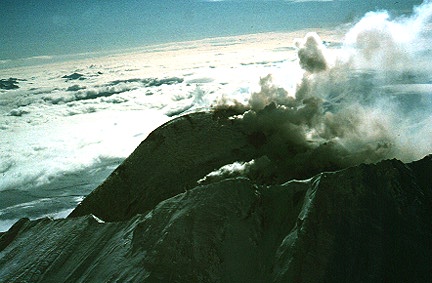 |
This older photograph of Bezymianny was taken by Jack Lockwood, U.S. Geological Survey.
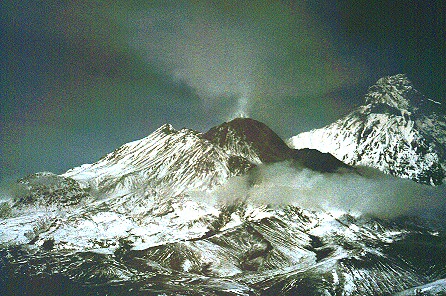 |
Bezymianny means "no name", a designation earned because the volcano had not erupted in historic time and it was over-shadowed by its neighbors, spectacular volcanoes like Kliuchevskoi. Photograph of Bezymianny from the southeast by Jack Lockwood, U.S. Geological Survey.
The volcano reawakened in 1955. About September 29, 1955, the number of earthquakes began to increase beneath the volcano. On October 22, the volcano began to erupt, throwing ash 3-5 miles (5-8 km) into the air. Pressure was building in the volcano and had pushed an old dome up more than 300 feet (100 m). Macdonald (1972, p. 226-227) used the study of Gorshkov (1959) to describe the climatic eruption:
"On March 30 a tremendous explosion destroyed the top of the mountain, lowering the height of the summit some 600 feet and forming a crater roughly a mile across. A great Vulcanian cloud was projected obliquely upward toward the east at an angle of 30-40 degrees to the horizon, reaching a height of 24 miles. At a distance of 15 miles, trees a foot in diameter were felled by the force of the blast. Eighteen miles away the bark of living trees was scorched and dead wood was set afire. Snow 3 to 6 feet deep was melted by hot ash along the center line of the blast. Simultaneously, great glowing avalanches swept down the mountain slopes, particularly into the Dry Hapitsa Valley. Six to eight miles east of the crater the ground was covered with sandy ash 1.5 feet thick, and 11 miles away the valley of the river was completely filled with deposits from the glowing avalanche. The avalanche gave rise to mudflows that continued down the valley."
This description and photos of Bezymianny after the climatic eruption (like the one at the top of this page) are remarkable similar to the May 18, 1980 eruption of Mount St. Helens.
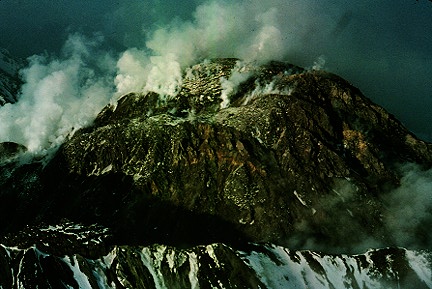 |
The March 30, 1956 eruption was a classic example of what volcanologists call a Peleean eruption. Peleean eruptions are characterized by the formation of domes and glowing avalanches. Photograph of a recent dome at Bezymianny taken by Jack Lockwood, U.S. Geological Survey.
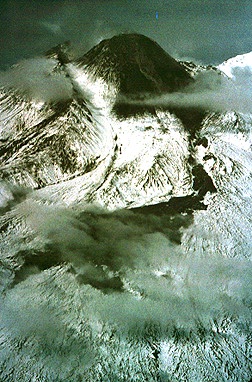 |
Following the climatic eruption, activity at Bezymianny has been limited to growth of the Novy intracrater dome. Dome growth was accompanied by numerous explosive episodes. Since the 1955-57 eruption, Bezymianny has erupted 34 times. Eruptions occur once or twice a year. Prior to this month's eruption, Bezymianny last erupted in September, 1994. Photograph of a recent dome at Bezymianny taken by Jack Lockwood, U.S. Geological Survey.
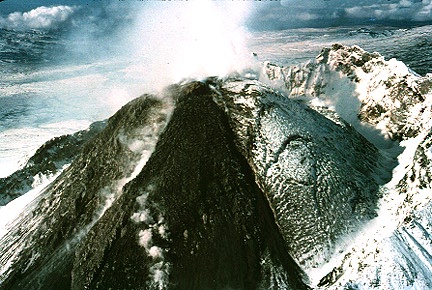 |
Photograph of a deposits from a recent dome collapse at Bezymianny taken by Jack Lockwood, U.S. Geological Survey.
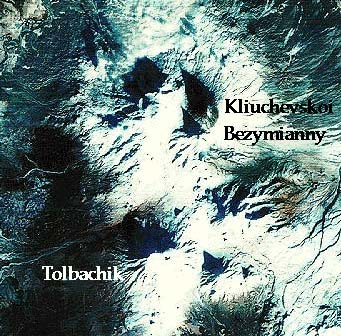 |
This Landsat MSS image was taken on November 12, 1972. It shows Kliuchevskoi and Tolbachik, two other active volcanoes near Bezymianny. Kliuchevskoi is a stratovolcano and the highest peak in Kamchatka (15, 900 feet; 4,850 m). It has erupted 85 times since 1697, most recently in 1994. Tolbachik is a basaltic shield volcano that last erupted in 1975-1976, generating one of the century's largest fissure eruptions.
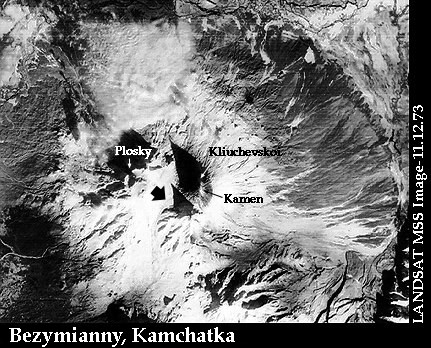
A 1973 LANDSAT photo of Bezymianny
Sources of Information:
Bogoyavlenskaya, G.Y., and Torley, R., 1982, 25 years of activity at Bezymianny: Volcano News, no. 13, p. 6-7.
Macdonald, G.A., 1972, Volcanoes: Prentice-Hall Inc., Englewood Cliffs, New Jersey, 510 p.
SEAN Bulletin, 1986, Smithsonian Institution, Washington, D.C., v. 11, no. 4, p. 1-28.
Simkin, T., and Siebert, L., 1994, Volcanoes of the World: Geoscience Press, Tucson, Arizona, 349 p.
Smithsonian Institution's Global Volcanism Network, 1995, Summary of Recent Activity: Bulletin of Volcanology, v. 56, p. 675-680.
Vlodavetz, V.I. and Piip, B.I., "Catalogue of the Active Volcanoes of the World Including Solfatara Fields: Part VIII, Kamchatka and Continental Areas of Asia,"International Volcanological Association, Napoli, Italy, 110 pp., 1959.
Additional details on the Bezymianny eruption are posted on the Alaska Volcano Observatory homepage.